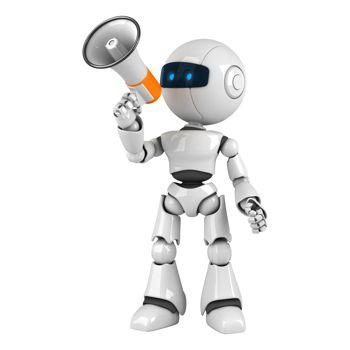A magazine where the digital world meets the real world.
On the web
- Home
- Browse by date
- Browse by topic
- Enter the maze
- Follow our blog
- Follow us on Twitter
- Resources for teachers
- Subscribe
In print
What is cs4fn?
- About us
- Contact us
- Partners
- Privacy and cookies
- Copyright and contributions
- Links to other fun sites
- Complete our questionnaire, give us feedback
Search:
AI Love You (2.0)
by Babajide Falade, Undergraduate at Queen Mary University of London

Wait...what if I’m an Artificial Intelligence, an AI? You could very well be! We all could be programs running on some super-duper computer operated by a green thing sipping something bitter to stay up as it rushes its homework: it’s due in tomorrow and it can’t figure out why its virtual creatures (us) keep forming groups and killing each other. How can I know for sure that I’m not an AI? If we create AIs, will we be able to tell it isn’t human? Will we know if there is anyone actually ‘in there’? Hmm...let’s ask SIRI... But first, let’s ease off the star juice and take a look ourselves.
When Tony Stark first donned a fantastic, hot-rod themed suit, chatting to his super intelligent computer J.A.R.V.I.S. that he treats like a person, and burst out of the pages into our reality he explosively re-introduced into the mass consciousness the very real concept of the robotic exoskeleton (a sort of robot you can wear). Just like Stark's god-like incarnations of the Iron Man Armour, J.A.R.V.I.S. is ACTUALLY HERE!!! Wait...what? OK maybe not quite, but early versions of both do exist. Exoskeletons are being used to help the paralysed walk and we may not have J.A.R.V.I.S. and we do have SIRI: a program smart enough to obey our commands!
What makes J.A.R.V.I.S. so different from SIRI? Not much really, perhaps it's just a matter of scale: J.A.R.V.I.S. might fire a repulsor beam whereas SIRI can only turn on the flashlight app. But is J.A.R.V.I.S. some kind of real being? Neither J.A.R.V.I.S. nor SIRI are actually anything close to the thinking, feeling, evolving humanoids of I, Robot, the replicants of Blade Runner or even the mechanical masters of the world that had (have?) us enslaved in The Matrix.
AI experts like Robert Sloan of the University of Illinois at Chicago. agree: "We're still very far from programs with common sense - AI that can answer comprehension questions with the skill of a child of 8". It's harder than it looks. It's also not at all clear what would cause the leap from an 'empty' AI that is just a dumb computer following instructions blindly with noone actually in there, to a fully functional AI that considers itself to be a 'person'. Perhaps that is a matter of scale too, though.
So how do we know what to aim for? In 1950 Alan Turing proposed a test, the Turing Test, that was intended to be a useful measure of intelligence. He suggested machine intelligence was the ability to perform at a human level in all cognitive tasks, so that a person asking the machine questions could not tell whether he/she was talking to a machine or a human.
That suggests a real AI would require a perfect grasp of language and be able to communicate fluently down to the accent. It would need some sort of information database to act as memory It would be able to reason for itself and use the information at its 'fingertips' to answer questions and make deductions. It would have advanced pattern recognition that can adapt to new situations. It would also ideally be able to detect objects around it and influence these things. Essentially an AI should be able to Communicate, Remember, Think and Do. Even with all that there still may not be 'anyone in there' of course.
Some companies are tackling the AI problem practically and are not trying to create ones that think of themselves as a person or for that matter turn Earth into a Marvel comic, or a planet of the robotic apes, instead they have focussed on specialised machines with ever more abilities to achieve specific tasks. Honda is working on a robot to help clear up the Fukushima nuclear crisis, for example. It is sending in an adaptation of one of its robots called ASIMO. They've been working on ASIMO for more than 20 years (you might want to open a savings account, these are not going to come cheap). They have managed to make it walk reliably by creating a balancing system that works much like the human hip, talk, detect faces so it 'knows' who it's talking to and a bunch of other really cool stuff.
Back to J.A.R.V.I.S.-like AIs. Did I mention mind-reading computers? Other scientists are working on them. They use electroencephalographs to measure the brains electrical activity (those funny hats with a bunch of octopus suckers and wires coming out of it) or even can be chips implanted in your brain. Simple thoughts at least can be recognised from the signals picked up. Sometime soon you may not even need voice commands as Jarvis 2.0 may be just another voice in your head, listening in to your thoughts: one that can actually make things happen.
You may feel sure that you are human and not an AI in an alien’s virtual world, but in the next decade or so it will be ever more difficult to tell if you are chatting with an AI or a human. You may not be able to tell whether your best friend, who is a voice in your head, is human or AI. Better be careful if you start to think you are falling in love with them!


